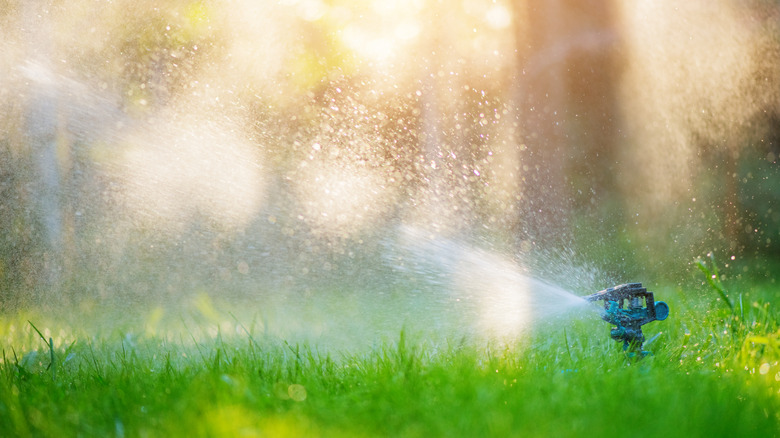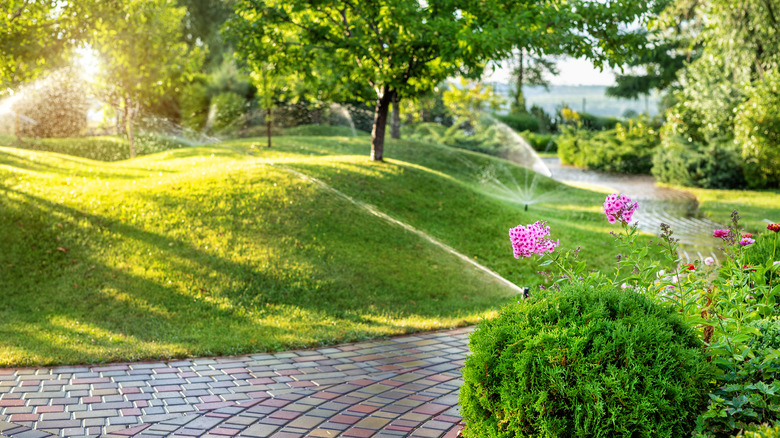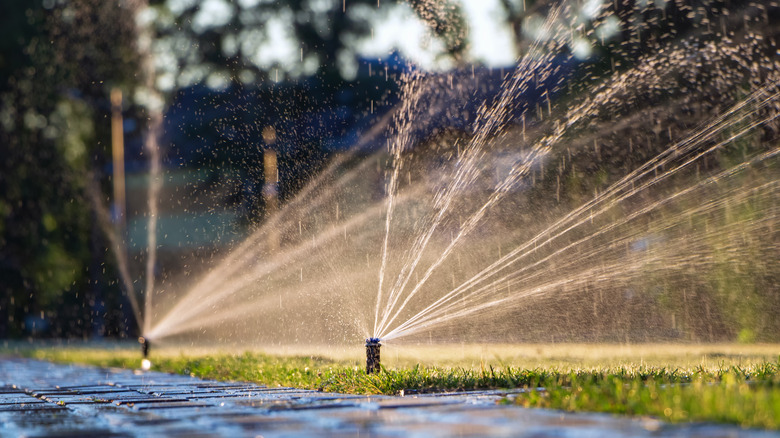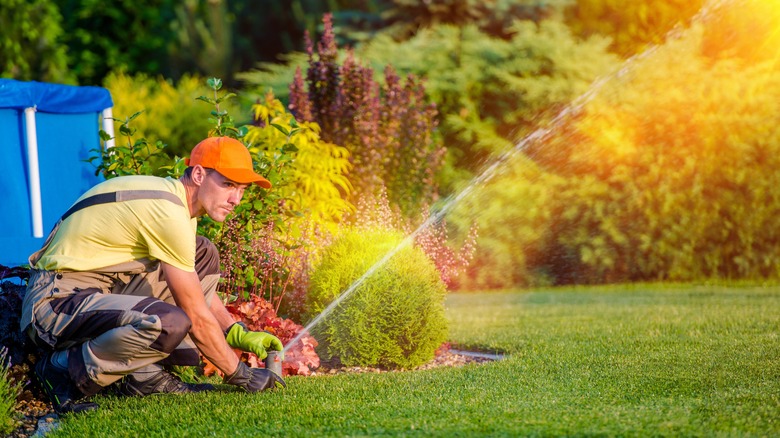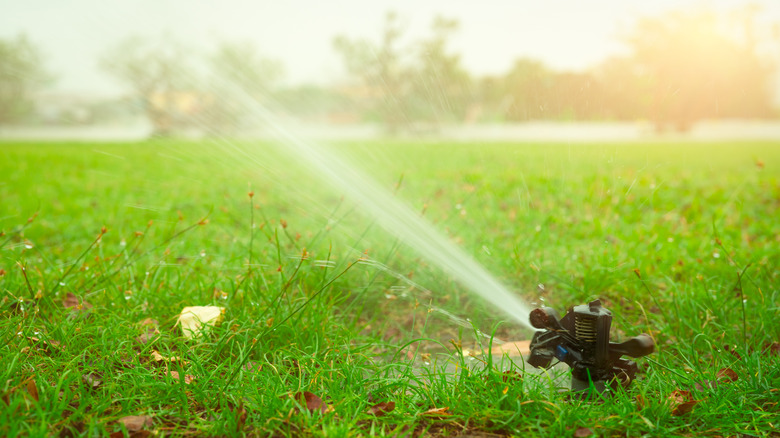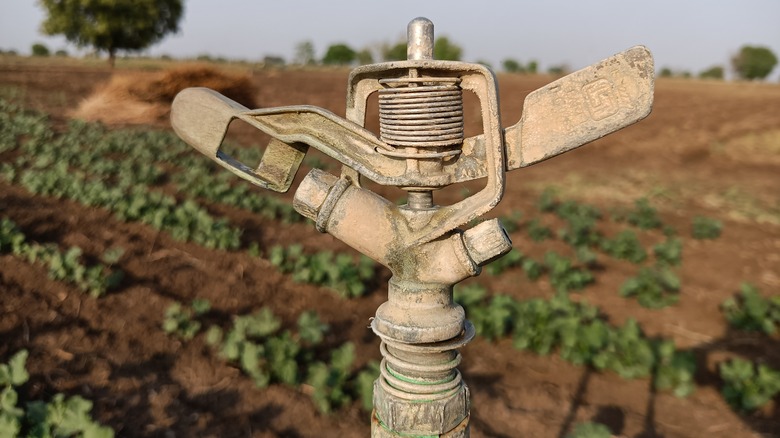How Much Does It Cost To Repair A Sprinkler System
Water use statistics are fascinating when it comes to the American home. Sprinklers, and an overarching irrigation system, can be found in just over half of all U.S. homes, according to Lawn & Landscape, but the ways in which people make use of these systems can vary dramatically across regional and even citywide areas. Reporting here illuminates the fact that 79% of homeowners don't keep track of their usage figures when it comes to watering the lawn and other aspects of the home's landscape.
Sprinklers are an embedded feature in the home, which is perhaps why so few people actively track the system's cycles and overall utilization. Indeed, it can be a difficult task for many to identify exactly where each sprinkler lies and how the undergrown network of PVC piping connects each node into the systems. Yet, it's obvious when one breaks, with a fountain of fast-running water spewing out into the lawn and down toward the gutter in the roadway below (or worse, pooling in the yard somewhere).
Angi reports that the typical sprinkler system repair costs $257, but this price can vary greatly depending on the scope and location of the damage — from as little as $10 to replace a single sprinkler head to more than $1,000 for extensive excavation and pipe replacement.
Factors for cost
Sprinkler repair is subject to a wide range of cost factors. Everything from the time of year to the complexities of your unique plumbing work can push the needle higher or lower in the final bill.
Location dictates a number of pricing factors
One facet of any new home improvement project lies in the geographic location that you call home. Every local market will have its own pricing models and prevailing conditions that affect the overall cost of any repair or renovation work that you might be undertaking. Sprinkler systems are no different.
According to the U.S. Geological Survey (USGS), irrigation across both residential homes and land used for commercial agriculture is markedly more pronounced in the western half of the United States (roughly divided along a line running north-south along Texas' eastern edge). Likewise, the Northeast sees a significant drop in the usage of local irrigation methods.
Depending on where you live, you may see inflated pricing due to lesser demand, or scarcity in PVC piping, PVC cement, and other essential equipment. Your geographical area will play a direct role in the types and quantity of stock that may be locally available, leading some homeowners to rely on eCommerce retailers as an alternative.
Material requirements are unavoidable
Forbes Advisor reports that the coronavirus pandemic has made for a series of unforeseen hardships across all sectors of the trades marketplace. This means that shortages in department and home improvement stores as a result of supply chain issues, staffing problems that lead to confusion on shelves, and increased demand for all manner of goods have pushed prices higher and supply lower.
Taking these issues into consideration is something that you must do, and ideally, you should be conducting routine maintenance on your sprinkler system in an effort to keep tabs on any repair needs that may be presenting themselves in order to try to tackle them at the most opportune time.
Additional costs
On top of material costs and the regional effects that can sway pricing, a homeowner seeking repairs to their sprinkler system will have to think about a few other pricing features.
Hiring a professional will boost the price tag
A professional plumber will increase the overall cost of repairs. HomeGuide estimates that plumbing services typically range from $500 to $800 for larger repairs, with the going rate hovering between $45 and $150 per hour. These prices can fluctuate based on the magnitude of the repair, and of course, the fact that sprinkler systems exist in an exterior environment, which can play a role in the service fees or hourly rate that your plumber may quote you.
For many irrigation repairs, a single pipe or sprinkler head connection requires attention, and the job can be completed within an hour or two; however, this isn't always the case. For most sprinkler repair jobs, you won't know the extent of the damage and, therefore, the requirements for finding a solution until you've dug up the piping and surveyed the problem directly.
For this reason, it can be difficult for a plumber to give you an accurate quote from the start, leading to the potential for a surprise bill at the end of the repair. It may be a good idea to dig out the problem area yourself before calling in a professional to gain a better sense of the repair works that will be needed and the overall price tag that comes with them.
The time of year can change your cost basis
Another factor that plays a role in the price of repairs is the seasonal change that occurs each year. CNBC reports that winter weather can lead to increased damage to pipes both inside the home and in the external space surrounding it.
Often, sprinkler systems simply won't be needed in the colder months, as plant life around your yard falls into dormancy in this period. Running your sprinklers then can lead to more harm than good, as water trapped within vulnerable components in the system (aging or weak joints, plastic sprinkler heads, etc.) can freeze and lead to breakages.
Additionally, because the residential sprinkler system is leaned on in the summer and typically shut down in the winter, parts can be harder to find as home improvement stores limit their displays in favor of seasonal sellers.
The water bill can play a role in your repair costs
Lastly, the longer you wait to repair a broken sprinkler system, the more the repair might cost you in overall expenses. A leaking pipe in the irrigation system beneath your yard may end up releasing water at a heavy flow rate, or simply a trickle, while you wait to make the necessary repairs. The longer it takes you to remedy this problem, the more water you are wasting each time you run the sprinkler system to provide for your yard and landscaping. Repairing your system provides better energy efficiency and water usage effectiveness that won't see you pumping your hard-earned cash down the drain.
Should you repair the system yourself
Repairing the sprinkler system on your own can be a great option for any homeowner that likes to work with their hands to deliver DIY solutions to home improvement and repair problems. For many homeowners, this is entirely possible and can save you a lot of money over the alternative.
Bob Vila recommends checking your sprinkler heads regularly for clogs and other obstructions. This is a simple task and can lengthen the expected lifetime of the entire system if done on a regular basis.
But some repairs will require digging, cutting, and installation of new pipe to complete. PVC is a long-lasting plastic and vinyl formulation (via About Mechanics) and will hold up to even the most extreme of elements across the years. That being said, PVC fails occasionally just like any other material. Fortunately, sprinkler system repairs are typically a pretty straightforward endeavor in most cases. With a PVC cutting tool (either a snipping tool or a wire-based cutting option), slicing through the affected area to patch a leak with a new pipe can be accomplished by most homeowners.
Using PVC cement and attaching new pipe in the affected area is all that it takes to repair a simple pipe malfunction. Likewise, most sprinkler heads screw on and off their fittings, making sprinkler head replacement a simple task as well. But a sprinkler system repair can quickly go downhill if you aren't careful. The tools used to accomplish this job can be dangerous if used incorrectly or without proper care. Further, those who lack experience in making these alterations can find themselves installing bulky and unnecessary pipe works that can lead to a drop in water pressure and the overall effectiveness of the system.
Working on a sprinkler system yourself can be a great way to minimize the expense, but it should only be done by those with the confidence to see the job through. A good measure of this might be in whether you expect to finish the job in a single day or not: Leaving the workspace with the repair incomplete should be avoided at all costs. Open sprinkler system piping can introduce obstructions, bacteria, and other unwanted elements into the irrigation network.
Why you need to address sprinkler repairs quickly
Sprinkler repairs might not seem like a big deal when taken out of context. But your sprinkler system lives in a particularly important position: Specifically, it occupies a network of space running all around the property and sometimes even underneath the house. This means that your sprinkler system can lead to extensive damage in other areas of the property.
A leak in the sprinkler system can lead to foundation damage
One of the most important issues that you can head off with routine sprinkler maintenance and timely repairs is damage that can be done to the foundation of your home. Foundation repair is often incredibly costly. Bob Vila reports a national average of $4,542 for general repairs. Minor cracks start at around $500 and major repair works price out at upward of $10,000 in the most extreme cases.
Pooling water that sits underneath the foundation of your home can erode the structural integrity of this element, and all too often, soggy soil that comes into contact with the foundation can lead to devastating effects (via Foundation Professionals of Florida).
Repairing your sprinkler system immediately is a simple way to contain your repair needs to a simple action item and mitigate future damages that can significantly alter your financial stability.
Leaky connections can saturate root mass, potentially killing off landscaping installations
In addition to the structural integrity of your property, leaking water can also kill off plant life. The most immediate effect of this issue lies in a yellowing and then dying lawn. Curb appeal remains a high priority among American homeowners, according to moving.com, and a sopping bog in the front yard puts a dampener on this goal, to be sure.
Angi reports that resodding the lawn can cost around $2,000 (and an estimated 40 hours of labor) when performing the task yourself, and runs up to about $4,520 when hiring a professional to rake out the dead grass and resod the yard.
Not only can a broken sprinkler system radically transform your home's visual appeal, it can cost you massively in both time and money.
Benefits of a properly working sprinkler system
A properly working sprinkler system is a crucial element in any home that supports a vibrant lawn and landscaping elements. But because this system is buried underground and rarely seen, it can be difficult to understand the true scope of the benefits provided to your family and your home.
A well-functioning sprinkler system is one that utilizes both reliable piping and sprinkler heads to cover the lawn's dimensions and a timer to ensure that watering is done at the most opportune moment (which, according to Popular Mechanics, is in the early morning hours).
Repairs in the irrigation system minimize waste and corresponding additional expenses
One of the most immediate changes that you'll see when shoring up your sprinkler system is a reduction in the water bill. A leaking pipe creates an additional drain on your water meter, and it's one that you're not actively using. By eliminating any waste in your home's water system, you can ensure that you're only paying for the water you're actually using.
According to Statista, the average monthly cost of water for residential users in the U.S. has been rising steadily since 2010, with an average bill of $72.93 per month for a family of four that uses 100 gallons per person. Relying on this data to understand where your usage falls in relation to the mean can be helpful in identifying any waste that exists inside your household or in the pipework that brings this essential resource onto the property.
Keeping the lawn looking healthy and beautiful is simple with a functioning sprinkler system
The aesthetic benefit provided by your sprinkler system is another powerful feature that can't be overlooked. Your sprinklers allow you to schedule waterings on a consistent basis, leading to better overall lawn health and a greener footprint for your garden beds, foliage, and the grass itself.
The sprinkler system can be complex or simple (via Better Homes & Gardens), and many homeowners find that their in-ground installation benefits from a supplemental overground addition, doubling down on the value and utility of the sprinklers as a result. No matter how you lay out your home's irrigation features, the sprinkler system is something that will keep your lawn looking beautiful all year if you take care of it.
